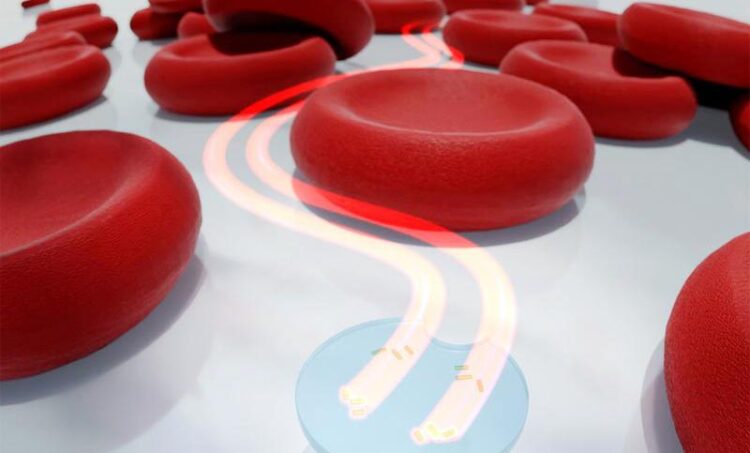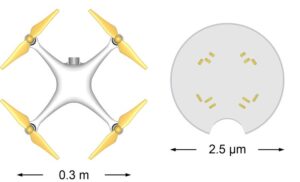Microdrones with light-driven nanomotors

Artistic representation of a microdrone with two active light-driven nanomotors between red blood cells.
Credit: Thorsten Feichtner
A hand-held laser pointer produces no noticeable recoil forces when it is “fired” – even though it emits a directed stream of light particles. The reason for this is its very large mass compared to the very small recoil impulses that the light particles cause when leaving the laser pointer.
However, it has long been clear that optical recoil forces can indeed have a very large effect on correspondingly small particles. For example, the tails of comets point away from the Sun partly due to light pressure. The propulsion of light spacecrafts via light sails has also been discussed repeatedly, most recently in connection with the “star shot” project, in which a fleet of miniature spacecrafts is to be sent to Alpha Centauri.
Ordinary quadcopter drones as models
In the journal Nature Nanotechnology, Würzburg physicists led by Professor Bert Hecht (Chair of Experimental Physics 5, Nano-Optics Group) have now shown for the first time that it is possible to not only efficiently propel micrometre-sized objects in an aqueous environment with light, but also control them precisely on a surface with all three degrees of freedom (two translational plus one rotational).
In doing so, they were inspired by ordinary quadcopter drones, where four independent rotors allow complete control of the movements. Such control possibilities offer completely new options for the usually extremely difficult handling of nano- and micro-objects, for example, for the assembly of nanostructures, for the analysis of surfaces with nanometre precision, or in the field of reproductive medicine.
Polymer discs with up to four light-driven nanomotors

Credit: Xiaofei Wu
The Würzburg microdrones consist of a transparent polymer disc measuring 2.5 micrometres in diameter. Up to four independently addressable nanomotors made of gold are embedded in this disc.
“These motors are based on optical antennas developed in Würzburg, – that is, tiny metallic structures with dimensions less than the wavelength of light,” says Xiaofei Wu, a postdoc in the Hecht research group. “These antennas were specifically optimised for receiving circularly polarised light. This allows the motors to receive the light regardless of the orientation of the drone, which is crucial for applicability. In a further step, the received light energy is then emitted by the motor in a specific direction to generate optical recoil force, which depends on the sense of rotation of the polarisation (clockwise or counterclockwise) and on either of two different wavelengths of light.”
It was only with this idea that the researchers were able to control their microdrones efficiently and precisely. Due to the very small mass of the drones, extreme accelerations can be achieved.
The development of the microdrones was challenging. It started back in 2016 with a research grant by the VW Foundation dedicated to risky projects. (https://www.uni-wuerzburg.de/aktuelles/einblick/single/news/nano-drohnen-mit-lichtantrieb/)
Precise fabrication based on single-crystal gold
The extremely precise fabrication of the nanomotors is crucial for the function of the microdrones. The use of accelerated Helium ions as a means to cut nanostructures from monocrystalline gold has turned out to be a game changer. In further steps, the drone body is produced using electron beam lithography. Finally, the drones must be detached from the substrate and brought into solution.
In further experiments, a feedback loop is being implemented to automatically correct external influences on the microdrones to control them more precisely. Furthermore, the research team strives to complete the control options so that the height of the drones above the surface can also be controlled. And of course, another goal is to attach functional tools to the microdrones.
Journal: Nature Nanotechnology
DOI: 10.1038/s41565-022-01099-z
Method of Research: Experimental study
Article Title: Light-driven Microdrones
Article Publication Date: 21-Apr-2022
All latest news from the category: Physics and Astronomy
This area deals with the fundamental laws and building blocks of nature and how they interact, the properties and the behavior of matter, and research into space and time and their structures.
innovations-report provides in-depth reports and articles on subjects such as astrophysics, laser technologies, nuclear, quantum, particle and solid-state physics, nanotechnologies, planetary research and findings (Mars, Venus) and developments related to the Hubble Telescope.
Newest articles

NASA: Mystery of life’s handedness deepens
The mystery of why life uses molecules with specific orientations has deepened with a NASA-funded discovery that RNA — a key molecule thought to have potentially held the instructions for…

What are the effects of historic lithium mining on water quality?
Study reveals low levels of common contaminants but high levels of other elements in waters associated with an abandoned lithium mine. Lithium ore and mining waste from a historic lithium…

Quantum-inspired design boosts efficiency of heat-to-electricity conversion
Rice engineers take unconventional route to improving thermophotovoltaic systems. Researchers at Rice University have found a new way to improve a key element of thermophotovoltaic (TPV) systems, which convert heat…



